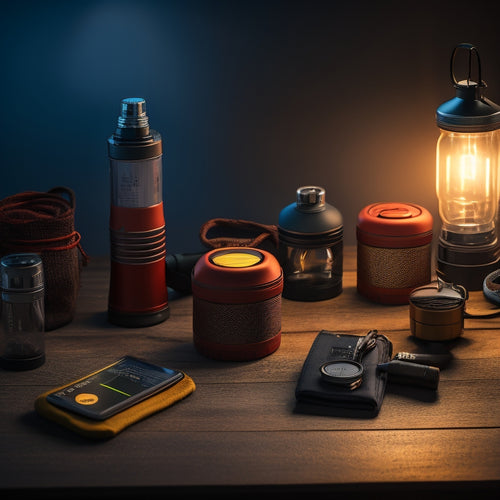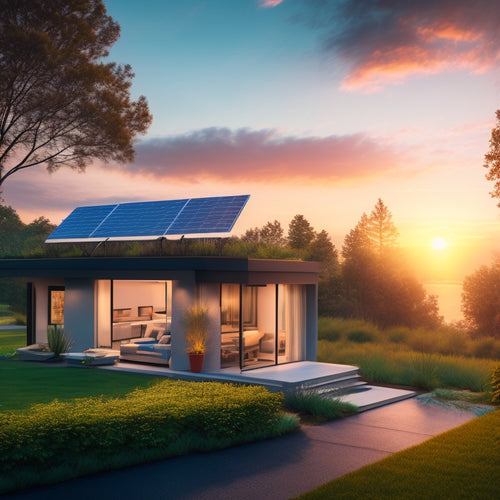
Maintaining Photovoltaic Panels for Longer Life
Share
To maintain your photovoltaic panels for a longer life, establish a proactive maintenance schedule that includes regular inspections and cleaning. Inspect for physical damage, and clean the panels based on local environmental conditions—frequent cleaning is essential in dusty areas. Use effective cleaning techniques to prevent scratches and maintain efficiency. Monitor performance consistently to track energy output and address any degradation factors. Choose high-quality panels with durable materials, as these enhance resilience against extreme weather. By taking these steps, you can optimize performance and longevity, ensuring your investment serves you well for years to come. There's more to investigate on maximizing your efficiency.
At a Glance
- Establish a proactive maintenance schedule to ensure regular inspections and early detection of potential issues.
- Regularly clean the panels to remove dust and debris, optimizing energy efficiency and performance.
- Monitor performance with tracking systems to assess energy output and identify any degradation in efficiency over time.
- Use high-quality materials that enhance durability and resistance to extreme weather conditions for longer-lasting panels.
- Take preventive measures based on environmental conditions, adjusting maintenance frequency to ensure optimal performance.
Cost-Effective Energy Solution
Investing in photovoltaic panels offers significant long-term savings on your energy bills, especially as utility rates rise.
Furthermore, their low maintenance requirements further reduce overall expenses, making them a smart financial choice.
By implementing effective energy management, you can optimize storage and consumption, enhancing the benefits of your solar investment.
Additionally, regular maintenance can extend the lifespan of your system, allowing for sustained energy independence.
Long-Term Savings Benefits
Although the initial installation of photovoltaic panels may seem intimidating, the long-term savings benefits they offer make them a cost-effective energy solution. By capturing solar energy, you can greatly reduce your monthly electricity bills. Over time, these savings can accumulate, allowing you to recoup your initial investment and enjoy substantial financial freedom.
Additionally, there are various tax incentives available that can further enhance your savings. Many governments offer rebates or credits for solar panel installations, which can offset your upfront costs. By taking advantage of these incentives, you can lower the effective price of your system, increasing your return on investment.
Financing options are also abundant, allowing you to spread the costs over time. Whether you choose a loan, lease, or power purchase agreement, these options can make solar energy more accessible. With predictable payments, you can budget efficiently while enjoying the benefits of reduced energy costs.
In the long run, photovoltaic panels not only provide a sustainable energy source but also contribute to your financial stability. Investing in solar technology is a step towards independence and a cleaner, more sustainable future.
Reduced Maintenance Expenses
One of the notable advantages of photovoltaic panels is their reduced maintenance expenses, which contribute to their overall cost-effectiveness as an energy solution. Unlike traditional energy systems that may require frequent repairs and extensive upkeep, photovoltaic systems are designed for durability and efficiency.
By implementing preventive measures, you can considerably lower the costs associated with maintenance. Establishing a proactive maintenance schedule is crucial. Regular inspections help identify potential issues before they escalate into costly repairs.
For instance, checking for debris accumulation or verifying connections are secure can prevent damage that leads to downtime. Cleaning the panels periodically enhances their efficiency, allowing them to operate at peak performance without requiring heavy financial input.
Moreover, many manufacturers offer warranties and support, which can further reduce your expenses. By optimizing your maintenance approach, you guarantee that your investment continues to yield energy savings without incurring additional costs.
Ultimately, your commitment to a well-structured maintenance routine not only extends the lifespan of your photovoltaic system but also solidifies it as a reliable, cost-effective energy solution for your needs, granting you the freedom to focus on what truly matters.
Increased Energy Efficiency
To achieve increased energy efficiency from your photovoltaic panels, regular cleaning is crucial to remove dirt and debris that can obstruct sunlight.
Additionally, guaranteeing compliance with industry standards and maintaining the proper tilt angle of your panels can optimize sun exposure throughout the day, markedly enhancing their performance.
Regular Cleaning Importance
Regular cleaning of photovoltaic panels is essential for optimizing energy efficiency. Over time, dust, dirt, bird droppings, and other debris can accumulate on the surface, obstructing sunlight and reducing the panels' ability to generate electricity.
To maintain peak performance, you should establish a cleaning frequency that suits your environment—typically, every 1 to 3 months is ideal for most regions. However, if you live in areas with heavy pollution or frequent storms, increase the frequency accordingly.
Employing effective cleaning techniques is equally important. You can use a soft brush or a squeegee with a gentle cleaning solution to avoid scratching the panels. For stubborn grime, consider using a mixture of water and mild detergent.
Always avoid abrasive materials and high-pressure washers, as they can damage the solar cells. Additionally, it's best to clean the panels during cooler parts of the day to prevent rapid evaporation of water, which can leave streaks.
Optimal Angle Adjustment
Adjusting the angle of your photovoltaic panels can greatly improve their energy efficiency. By implementing angle adjustment techniques, you can guarantee that your panels capture the maximum amount of sunlight throughout the day. The sun's position changes with the seasons, so regular tilt adjustments are essential for maintaining peak performance.
To achieve this, consider the latitude of your location and the time of year. For instance, during summer months, a lower tilt angle might be more effective, while a steeper angle can capture more sunlight in winter. You can use adjustable mounting systems that allow for easy modifications based on seasonal changes or even daily variations in sunlight.
Additionally, if you're in a region with frequent cloudy days, a slight increase in angle might help improve energy capture during those periods. Monitoring your energy output can also provide observations into the effectiveness of your current angle.
Durability and Weather Resistance
When considering the durability and weather resistance of photovoltaic panels, you must evaluate how extreme weather can affect their performance.
High-quality materials contribute greatly to a panel's longevity, ensuring they withstand harsh conditions like heavy rain, snow, and intense sunlight.
For instance, solar panels are tested for environmental stress tests to simulate extreme conditions and assess their reliability.
Understanding these factors will help you make informed decisions about the maintenance and longevity of your solar investment.
Impact of Extreme Weather
Extreme weather conditions considerably affect the durability and weather resistance of photovoltaic panels. You need to be aware that storm damage can lead to physical impairments, compromising the efficiency of your system.
Temperature fluctuations can cause materials to expand and contract, which may weaken connections over time.
Hail impact poses another significant risk; even small hailstones can chip or crack panels, affecting their performance.
Moreover, humidity effects can lead to moisture infiltration, potentially causing corrosion of internal components. Ensuring your panels have adequate wind resistance is essential, especially in hurricane-prone areas where high winds can detach or destroy them.
Snow accumulation can also create issues, as heavy loads may stress the panels beyond their design limits.
In addition, lightning strikes can damage your system if it isn't properly grounded.
Material Quality and Longevity
The quality of materials used in photovoltaic panels plays an essential role in their durability and overall longevity. When you're considering material selection for your solar installation, focus on high-grade components that can withstand environmental stressors. The right materials not only improve performance but also extend the life of your panels.
In the panel construction process, make certain that you choose tempered glass for the surface. This material is resistant to impacts and scratches, enhancing the panel's ability to endure hail, debris, and other potentially damaging elements.
Additionally, pay attention to the framing; aluminum is often preferred due to its lightweight and corrosion-resistant properties.
The encapsulants used to shield the photovoltaic cells should also be of superior quality. Ethylene-vinyl acetate (EVA) is a popular choice, as it provides excellent protection against moisture and UV rays.
Investing in high-quality materials will lead to fewer maintenance issues and a longer lifespan for your panels.
Selecting Based on Energy Output
When selecting photovoltaic panels, you need to assess their energy output to guarantee they meet your needs.
Consider the efficiency rating, as it directly impacts the amount of electricity generated under various conditions.
Choose high-efficiency panels with conversion rates above 20% to maximize performance.
Energy Output Assessment
Selecting photovoltaic panels based on energy output is crucial for maximizing the efficiency of your solar energy system. When evaluating panels, focus on their energy yield, which reflects the amount of energy they can produce under standard test conditions. Higher energy yield means you'll capture more power from sunlight, optimizing your investment.
To guarantee consistent performance, implement performance monitoring systems that track the energy output of your solar array. This allows you to identify any drop in efficiency over time, enabling timely maintenance or panel replacement. Regular performance assessments can reveal how environmental factors, like shading or dirt accumulation, affect your panels' energy yield.
Consider the panel's rated capacity, measured in watts, as this indicates its potential output. Select models that match your energy needs while maximizing production. Additionally, pay attention to degradation rates; panels typically lose efficiency over time, impacting long-term energy yield.
Ultimately, the right choice in photovoltaic panels can lead to significant energy savings and contribute to your freedom from traditional energy sources. By prioritizing energy output and instituting performance monitoring, you'll guarantee your solar system operates at peak efficiency for years to come.
Efficiency Rating Considerations
Evaluating the efficiency ratings of photovoltaic panels is vital for optimizing your solar energy system. When selecting panels, you'll want to compare their efficiency benchmarks, which indicate how effectively they convert sunlight into electricity.
Higher efficiency ratings mean more energy output per square foot, allowing you to maximize your installation's performance without needing excessive space.
Consider the specific energy needs of your home or business. If you have limited roof space, opting for panels with higher efficiency will help you achieve your energy goals more effectively.
Additionally, keep in mind that efficiency isn't the only factor; durability, warranty, and performance in varying weather conditions also play important roles in your decision.
You should also look into the temperature coefficients of potential panels. A lower temperature coefficient indicates better performance optimization in hot conditions, ensuring your system remains efficient even when the sun's intensity rises.
Ultimately, by carefully selecting photovoltaic panels based on efficiency ratings, you can enhance your energy independence and reduce long-term costs, making a significant impact on your sustainable energy endeavor.
Lower Maintenance Requirements
When it comes to photovoltaic panels, you'll appreciate their minimal cleaning needs.
Most models are designed to self-clean during rain, reducing the frequency of manual maintenance.
This feature not only saves you time but also guarantees peak performance with minimal effort.
Minimal Cleaning Needs
Maintaining photovoltaic panels involves minimal cleaning needs, making them an efficient choice for energy generation. The frequency of cleaning largely depends on your location and the type of solar panel you use. Generally, most systems can operate effectively with little maintenance, as they are designed to shed dust accumulation naturally.
However, understanding the specific requirements for different solar panel types can help you optimize performance. Here's a quick comparison:
| Solar Panel Type | Cleaning Frequency |
|---|---|
| Monocrystalline | Low (1-2 times/year) |
| Polycrystalline | Moderate (2-3 times/year) |
| Thin-film | High (3-4 times/year) |
In areas prone to heavy dust, you might need to clean panels more frequently to maintain efficiency. Rain can often help wash away dirt, but a manual clean with water and a soft brush may be necessary in dry regions. By staying proactive about cleaning, you guarantee your panels operate at peak performance, giving you the freedom to utilize renewable energy with minimal hassle.
Frequently Asked Questions
How Often Should I Clean My Photovoltaic Panels?
You should clean your photovoltaic panels every six months for best performance. Use effective cleaning techniques during dry seasons. Regular maintenance guarantees maximum efficiency and helps you utilize solar energy effectively, giving you freedom from high energy costs.
What Tools Are Needed for Panel Maintenance?
For panel maintenance, you'll need cleaning supplies like a soft brush, squeegee, and biodegradable soap. Establish a maintenance schedule to guarantee peak performance and longevity, keeping your system efficient and maximizing your energy independence.
Can I Perform Maintenance Myself, or Hire a Professional?
You can choose DIY maintenance for hands-on freedom or opt for professional services to guarantee thorough care. Weigh your skills and time against potential risks, and decide what best suits your needs and comfort level.
What Signs Indicate My Panels Need Repair?
You should watch for decreased panel performance, visible cracks, discoloration, or corrosion. These signs can lead to higher repair costs if ignored. Regular inspections help guarantee you catch issues early and maintain efficiency.
Do Weather Conditions Affect Maintenance Frequency?
Yes, weather impacts maintenance frequency. Harsh environmental factors like heavy rain, snow, or extreme temperatures can accelerate wear on your panels, necessitating more regular inspections and upkeep to guarantee peak performance and longevity.
Explore More
In the quest for renewable energy, you might think maintaining photovoltaic panels is a chore. Ironically, by investing a little time and effort, you're actually ensuring a longer lifespan and higher efficiency. It's amusing how something that seems like a hassle can lead to cost savings and increased energy output. So, while others overlook maintenance, you'll reap the rewards of your diligence, enjoying clean energy and lower bills—proving that sometimes, a little care goes a long way.
Related Posts
-

Best Solar Powered Flashlights for Emergency Situations
When you're choosing the best solar-powered flashlights for emergency situations, focus on their brightness, battery ...
-

The Future of Residential Energy Storage
The future of residential energy storage looks promising and cost-effective for you. With lithium-ion battery prices ...
-

Essential Hiking Lights for Safety and Fun
When you're hitting the trails, essential hiking lights are vital for safety and fun. A lightweight headlamp offers h...


